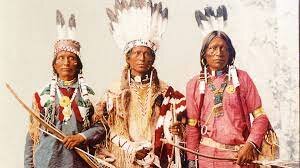-
 Evidence based on human remains supports the idea that Native American expansion happened 16,000 years ago, since the "earliest securely dated sites [are about] 15,000 years ago." Based on "actual" evidence, the ancestors were likely isolated in Asia, not in Siberia or Alaska.
Evidence based on human remains supports the idea that Native American expansion happened 16,000 years ago, since the "earliest securely dated sites [are about] 15,000 years ago." Based on "actual" evidence, the ancestors were likely isolated in Asia, not in Siberia or Alaska. -
 Explorer Christopher Columbus (1451–1506) is known for his 1492 'discovery' of the New World of the Americas on his ship Santa Maria. He opened up the Americas for Exploration. But the Native Indian tribes were already here.
Explorer Christopher Columbus (1451–1506) is known for his 1492 'discovery' of the New World of the Americas on his ship Santa Maria. He opened up the Americas for Exploration. But the Native Indian tribes were already here. -
 The Spanish were among the first Europeans to explore the New World and the first to settle in what is now the United States. They form part of the current Latino ethnic group.
The Spanish were among the first Europeans to explore the New World and the first to settle in what is now the United States. They form part of the current Latino ethnic group. -
 Italian explorer Amerigo Vespucci named America. Amerigo Vespucci was a 16th-century navigator after whom the American continents were named.
Italian explorer Amerigo Vespucci named America. Amerigo Vespucci was a 16th-century navigator after whom the American continents were named. -
 Jamestown Colony became the first permanent English settlement in North America. The racial category of Whites was established here.
Jamestown Colony became the first permanent English settlement in North America. The racial category of Whites was established here. -
 The first African America recorded to have been abducted into slavery. 20 people from the kingdom of Ndongo in Angola were abducted and shipped to Point Comfort, VA. This was meant to supply labor for the English settlers.
The first African America recorded to have been abducted into slavery. 20 people from the kingdom of Ndongo in Angola were abducted and shipped to Point Comfort, VA. This was meant to supply labor for the English settlers. -
 John Elliot published a catechism book in the Indian language. The beginning of the integration of Native Indians into the society.
John Elliot published a catechism book in the Indian language. The beginning of the integration of Native Indians into the society. -
 Chinese immigrants are the third-largest foreign-born group in the United States, after Mexicans and Indians. Chinese immigration to the United States has consisted of two waves, the first arriving in the mid-1800s and the second from the late 1970s to the present.
Chinese immigrants are the third-largest foreign-born group in the United States, after Mexicans and Indians. Chinese immigration to the United States has consisted of two waves, the first arriving in the mid-1800s and the second from the late 1970s to the present. -
 It is estimated that as many as 4.5 million Irish arrived in America between 1820 and 1930. Between 1820 and 1860, the Irish constituted over one third of all immigrants to the United States. In the 1840s, they comprised nearly half of all immigrants to this nation.
It is estimated that as many as 4.5 million Irish arrived in America between 1820 and 1930. Between 1820 and 1860, the Irish constituted over one third of all immigrants to the United States. In the 1840s, they comprised nearly half of all immigrants to this nation. -
 This treaty, signed on February 2, 1848, ended the war between the United States and Mexico. By its terms, Mexico ceded 55 percent of its territory, including the present-day states of California, Nevada, Utah, New Mexico, most of Arizona and Colorado, and parts of Oklahoma, Kansas, and Wyoming. The Mexicans in these territories also gained American citizenship
This treaty, signed on February 2, 1848, ended the war between the United States and Mexico. By its terms, Mexico ceded 55 percent of its territory, including the present-day states of California, Nevada, Utah, New Mexico, most of Arizona and Colorado, and parts of Oklahoma, Kansas, and Wyoming. The Mexicans in these territories also gained American citizenship -
 In these two centuries, immigration into the united states has been highly diverse, with people from all over the world immigrating into the United States.
In these two centuries, immigration into the united states has been highly diverse, with people from all over the world immigrating into the United States.